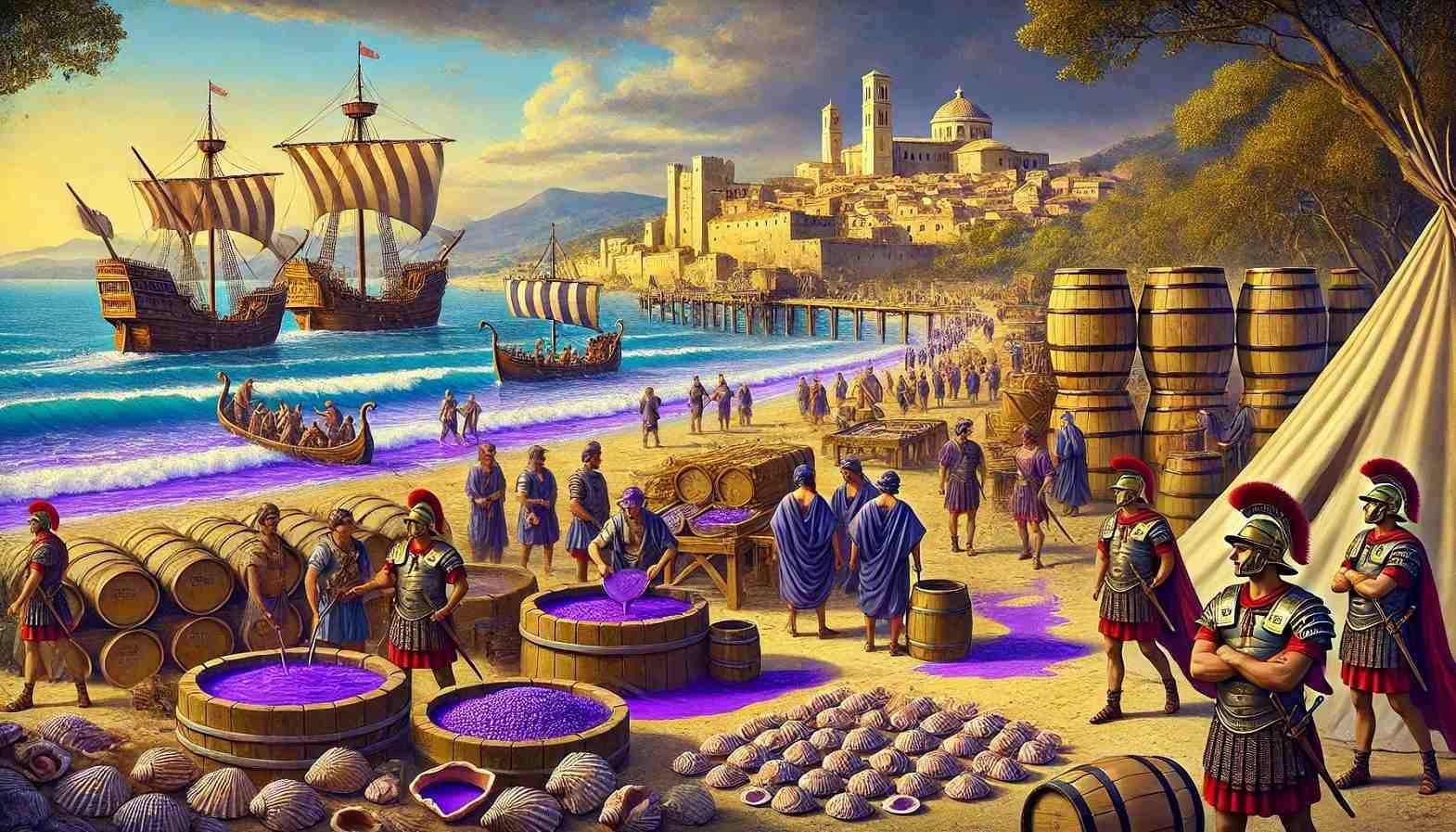Throughout history, fashion has been more than just a means of personal expression. It has acted as a powerful symbol of wealth, status, and influence, driving nations to seek control over its production and distribution. Monarchs and empires used luxurious materials like silk, wool, fur, and even specific colours such as purple to impose their dominance, and this obsession with fashion often led to political tensions, economic rivalries, and in some cases, full-scale wars. It was not only pride that drove the urge to own or control these materials—it was also an act of power and strength.
From the ancient wars over purple dye to spying operations for silk, there are many historical examples where kingdoms fought over fashion-related goods. We will look at a few of these fascinating instances in this article, as well as how seemingly insignificant fashion choices sparked international conflict.
The Battle for Purple Dye: The Tyrian Purple Wars
In ancient times, purple was not just a colour; it was the colour. Extracted from the murex shellfish, Tyrian purple was so expensive and rare that it was reserved exclusively for royalty and high-ranking officials. The people who first discovered this procedure, the Phoenicians, were extremely protective of their secret. However, the immense value of purple dye made it an object of desire for other empires. Rome, in particular, recognised the economic and symbolic significance of Tyrian purple. The Roman elite craved it for their clothing, associating it with imperial power. However, obtaining the dye meant dealing with Phoenician merchants and their Carthaginian allies. This economic tension simmered as Rome sought to control key Mediterranean trade routes, leading to the infamous Punic Wars between Rome and Carthage from 264–146 BC.
While the Punic Wars were primarily territorial, controlling lucrative commodities like Tyrian purple played a significant role. After Rome’s eventual victory, they secured the Mediterranean, and purple became a colour exclusively worn by the Roman emperors, symbolising their unrivalled authority1.
The Silk Wars: Secrets of the East
For centuries, silk was the most sought-after luxury fabric in the world. China’s ability to produce it and its monopoly on its trade made the country immensely wealthy and powerful. The silk trade flourished along the Silk Road, connecting East to West, but the secret of silk production was ferociously guarded by the Chinese.
During the 6th century AD, the Byzantine Empire under Emperor Justinian was desperate to reduce its reliance on Chinese silk. The empire had grown weary of paying exorbitant prices for silk and dealing with Sassanid Persia, which controlled much of the trade routes. Justinian devised a plan: he sent two monks on a clandestine mission to China, disguised as travellers.
The monks successfully smuggled silkworm eggs and mulberry seeds back to Byzantium hidden in their walking staffs. With this, the Byzantines developed their silk industry and permanently altered the trade’s balance of power for luxury fabrics. The empire stopped relying on the East for this precious commodity as Byzantine silk emerged as a mainstay for European courts2.
Feathers and Furs: The Wars of Extravagance
In the 16th and 17th centuries, Europe’s aristocracy was obsessed with extravagance. Fashion was a means of displaying wealth and status, and nothing conveyed luxury quite like exotic feathers and fur. Fur from exotic animals like beavers was highly valued for clothes and accessories, and extravagant hats embellished with rare bird feathers were in trend3.
As European exploration expanded into the New World, feathers and furs became some of the most sought-after goods. The French, Dutch, and the British—all competed fiercely for control of the North American fur trade, which resulted in economic and territorial conflicts. One of the most notable of these was the French and Indian War (1754–1763), which was part of a larger struggle between France and Britain for dominance in North America4.
Although the war was largely about territory and power, the fur trade played a significant role in fuelling the conflict. The French had established strong trading relationships with Native American tribes, exchanging European goods for beaver pelts, which were then sent back to Europe to be made into hats and other garments. The British, recognising the economic potential, sought to break this monopoly, leading to years of conflict. In the end, Britain won, taking possession of many parts of North America as well as the moneymaking fur trade3.
Buttons and Battlefields: The Anglo-Spanish War Over Fashion
At the peak of the Renaissance, buttons became not just functional fasteners but symbols of prestige. Wealthy nobles adorned their clothing with elaborate buttons made from precious metals and stones, and no expense was spared in their design. However, this growing obsession led to an unlikely diplomatic incident between England and Spain during the late 16th century.
During a diplomatic mission, a Spanish envoy made an offhand remark criticising the extravagant buttons on an English noble’s outfit. This seemingly trivial insult quickly escalated into a diplomatic dispute, as Spain viewed it as an affront to their own fashion sensibilities. The rivalry between England and Spain, already tense due to religious differences and territorial ambitions, found a strange expression in fashion4.
This incident helped fuel existing animosities, and the Anglo-Spanish War (1585–1604) erupted shortly afterwards. While fashion was far from the sole cause of the war, the emphasis on appearance and courtly display contributed to the growing rivalry between the two powers. The war culminated in the famous defeat of the Spanish Armada, a pivotal moment in the English history4.
The Great Lace Wars: Luxury and Trade Rivalries
Lace, one of the most delicate and intricate textiles, became a symbol of opulence in European courts during the 17th and 18th centuries. France, under King Louis XIV, was particularly enamoured with lace, which was used to decorate clothing, linens, and furnishings in the royal court. However, much of the finest lace came from the Netherlands, and Louis XIV was not content to import it5.
The French king banned the importation of Dutch lace and ordered French artisans to replicate the techniques. This move was not only a matter of national pride but also part of a larger economic rivalry between France and the Netherlands, which extended into other luxury goods like textiles and porcelain5.
The smuggling of lace across borders became rampant, and trade restrictions led to economic tensions. In response, French lace-makers developed their own styles, such as Alencon lace, which became renowned throughout Europe. The rivalry over lace production is a testament to how luxury goods like fashion could spark economic conflict between nations5.
The Cotton Wars: Colonialism and Revolution
By the 18th century, cotton had become the fibre of choice for much of Europe’s burgeoning textile industry. The British Empire’s desire to control cotton production played a significant role in its colonial expansion, particularly in India and the American South. Cotton’s global importance would eventually spark revolutions and reshape empires6.
In India, Britain’s colonisation was largely driven by the desire to control the production of cotton fabrics, which were highly prized in Europe. British-imposed trade restrictions on Indian cotton led to widespread resentment and economic exploitation, contributing to the rise of Indian nationalist movements, such as Mahatma Gandhi’s Swadeshi movement, which advocated for local production of cotton goods7.
In the American colonies, cotton also played a crucial role in the economic tensions that led to the American Revolution. Britain’s reliance on American cotton to fuel its textile industry created deep economic ties, but the colonists grew frustrated with British control over trade and taxation. This contributed to the eventual push for independence in 1776.
Conclusion
Fashion, far from being a superficial aspect of history, has played a crucial role in shaping global conflicts and political tensions. Whether through the control of luxury fabrics like silk and lace or the symbolic power of colours and accessories, fashion has driven empires to war, spurred espionage, and fuelled economic rivalries. These stories show that what we wear has often been a reflection of the power struggles and ambitions of the world’s greatest empires. From ancient Rome’s purple dye to the Great Lace Wars of Louis XIV, fashion has always been about more than just style—it has been a powerful force in world history.









Comments